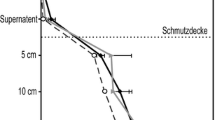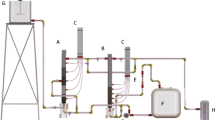Abstract
A study was carried out to assess the efficiency of filtration in reducing microbial contamination in municipal secondary effluent. After primary and secondary treatments, the wastewater underwent filtration through sand/hydroanthracite filters. A total of 20 samplings were made, each consisting of two instant samples (secondary effluent and filtered effluent). Each of the 40 samples was tested for: total and faecal coliforms,Escherichia coli, enterococci and somatic coliphages. The mean concentrations detected in the secondary effluent were in the order of 5 log for the total and faecal coliforms, 4 log for enterococci andEscherichia coli, and approx. 3 log for the coliphages. The filtration showed a higher efficacy in the reduction of feacal coliforms,Escherichia coli and in particular total coliforms. The results obtained for enterococci and coliphages were significanty lower. Filtration alone was not enough to reduce the bacterial indicators to within Italian legal limits, and showed a poor capacity to abate coliphages. However, by performing the filby-products and a consequent reduction in the chemical risk for the general population.
Similar content being viewed by others
References
APHA,AWWA,WPCF (1998). Standard methods for the Examination of Water and Wastewater, 20th edn. Wahington, DC USA.
Arana I., Santorum P., Muela A., Barcina I. (1999). Chlorination and ozonation of waste water:comparative analysis of efficacy through the effect onEscherichia coli membranes. J. Appl. Microbiol., 86: 883–888.
Caretti C., Lubello C. (2003). Wastewater disinfection with PAA and UV combined treatment: a pilot plant study. Water Res., 37: 2365–2371.
Collivignarelli C., Bertanza G., Pedrazzani R. (2000). A comparison among different wastewater disinfection systems: experimental results. Environ. Technol., 21: 1–16.
Crebelli R., Conti L., Monarca S., Feretti D., Zerbini I., Zani C., Veschetti E., Cutilli D., Ottaviani M. (2005). Genotoxicity of the disinfection by-products resulting from peracetic acid or hypochlorite disinfected sewage wastewater. Water Res., 39: 1105–1113.
Decreto del Ministero dell’Ambiente e della Tutela del Territorio n. 185, 12 giugno (2003). Regolamento recante norme tecniche per il riutilizzo delle acque reflue in attuazione dell’articolo 26, comma 2, del decreto legislativo 11 maggio 1999, n. 152. G.U. della Repubblica Italiana n. 169 del 23 Luglio 2003.
DL n. 152, 11 maggio (1999). Disposizioni sulla tutela delle acque dall’inquinamento e recepimento della direttiva 91/271/CEE concernente il trattamento delle acque reflue urbane e della direttiva 91/676/CEE relativa alla protezione delle acque dall’inquinamento provocato dai nitrati provenienti da fonti agricole. G.U. della Repubblica Italiana (Suppl) n. 124 del 29 maggio 1999.
Farahbakhsh K., Smith D.W. (2004). Removal of coliphages in secondary effluent by microfiltration-mechanisms of removal and inpact of operating parameters. Water Res, 38: 585–592.
Gehr R., Wagner M., Veerasubramanian P., Payment P. (2003). Disinfection efficiency of peracetic acid, UV and ozone after enhanced primary treatment of municipal wastewater. Water Res., 37: 4573–4586.
Hill V.R., Kantardjieff A., Sobsey M.D., Westerman P.W. (2002). Reduction of enteric microbes in flushed swime wastewater treated by a biological aerated filter and UV irradiation. Water Environ. Res., 74: 91–99.
Hamoda M.F., Al-Ghusain I., Al-Jasem D.M. (2004). Application of granular media filtration in wastewater reclamation and reuse. J. Environ. Sci. Health, Part A: Tox. Hazard Subst. Environ. End., 39 (2): 385–395.
ISO10705-2 (2001). Qualità dell’acqua. Ricerca e conteggio di colifagi somatici. Ente Nazionale Italiano di Unificazione. Milano.
Jiang S., Noble R., Chu W. (2001). Human adenoviruses and coliphages in urban runoff-impacted coastal waters of southern California. Appl. Environ. Microb., 67: 179–184.
Katz A., Narkis N. (2001). Removal of chlorine dioxide disinfection by-products by ferrous salts. Water Res., 35: 101–108.
Kim J., Marshall M.R., Du W.X., Otwell W.S., Wei C.I. (1999). Determination of chlorate and chlorite and mutagenicity of seafood treated with aqueous chlorine dioxide. J. Agr. Food Chem., 47: 3586–3591.
Kiso Y., Jung Y.J., Park M.S., Wang W., Shimase M., Yamada T., Min K.S. (2005). Coupling of sequencing batch reactor and mesh filtration: operational parameters and wastewater treatment performance. Water Res., 39: 4887–4898.
Kitis M. (2004). Disinfection of wastewater with peracetic acid: a review. Environ. Int. 30: 47–55.
Koivunen J., Siitonen A., Heinonen-TanskiH. (2003). Elimination of enteric bacteria in biological-chemical wastewater treatment and tertiary filtration units. Water Res.37: 690–698.
Koivunen J., Heinonen-Tanski H. (2005a).Inactivation of enteric microorganisms with chemical disinfectants, UV irradiation and combined chemical/UV treatments. Water Res., 39: 1519–1526.
Koivunen J., Heinonen-Tanski H. (2005b). Peracetic acid (PAA) disinfection of primary, secondary and tertiary treated municipal wastewater. Water Res., 39: 4445–4553.
Lazarova V., Janex M., Fiksdal L., Oberg C., Oberg C., Barcina I., Pommepuy M. (1998). Advanced wastewater disinfection technologies: short and long term efficiency. Water Sci. Technol., 38: 109–117.
Lubello C., Caretti C., Gori R. (2002). Comparison between PAA/UV and H2O2/UV disinfection for wastewater reuse. Water Sci. Technol., 2: 205–212.
Monarca S., Feretti D., Collivignarelli C., Guzzella L., Zerbini I., Bertanza G., Pedrazzani R. (2000). The influence of different disinfectants on mutagenicity and toxicity of urban wastewater. Water Res., 34: 4261–4269.
Rajala R.L., Pulkkanen M., Pessi M., Heinonen-Tanski H. (2003). Removal of microbes from municipal wastewater effluent by rapid sand filtration and subsequent UV irradiation. Water Sci. Technol., 17: 157–162.
Smith R.P., Willhite C.C. (1990). Chlorine dioxide and hemodialysis. Regul. Toxicol. Pharm., 11: 42–62.
Stampi S., De Luca G., Zanetti F. (2001). Evaluation of the efficiency of peracetic acid in the disinfection of sewage effluents. J. Appl. Microbiol., 91: 833–838.
Stampi S., De Luca G., Onorato M., Ambrogiani E., Zanetti F. (2002). Peracetic acid as an alternative wastewater disinfectant to chlorine dioxide. J. Appl. Microbiol., 93: 725–731.
Tanner B.D., Kuwahara S., Gerba C.P., Reynolds K.A. (2004). Evaluation of electrochemically generated ozone for the disinfection of water and wastewater. Water Sci. Technol., 50: 19–25.
te Poele S., Menkveld W., Boom J., van Bragt W. (2005). Effluent treatment by multimedia filtration, microfiltration and ultrafiltration: results of a pilot investigation at WWTP Hoek van Holland. Water Sci. Tecnhol., 52: 99–105.
Tyrrel S., Ripley S.P., Watkins W.D. ((1995). Inactivation of bacterial and viral indicators in secondary sewage effluents, using chlorine and ozone. Water Res., 29: 2483–2490.
Veschetti E., Cutilli D., Bonadonna L., Briancesco R., Martini C., Cecchini G., Anastasi P., Ottaviani M. (2003). Pilot-plant comparative study of peracetic acid and sodium hypochlorite wastewater disinfection. Water Res., 37: 78–94.
Wagner M., Brumelis D., Gehr R. (2002). Disinfection of wastewater by hydrogen peroxide or peracetic acid: development of procedures for measurement of residual disinfectant and application to a physicochemically treated municipal effluent. Water Environ. Res., 74: 33–50.
Xu P., Janex M.L., Savoye P., Cockx A., Lazarova V. (2002). Waste-water disinfection by ozone: main parameters for process design. Water Res., 36: 1043–1055.
Zanetti F., Stampi S., De Luca G., Varoli O., Tonelli E. (1996). Comparative disinfection of secondary-treatment sewage with chlorine dioxide and bromine chloride. Zbl. Hyg. Umvelmed, 198: 567–579.
Author information
Authors and Affiliations
Corresponding author
Rights and permissions
About this article
Cite this article
Zanetti, F., De Luca, G. & Sacchetti, R. Microbe removal in secondary effluent by filtration. Ann. Microbiol. 56, 313–317 (2006). https://doi.org/10.1007/BF03175023
Received:
Accepted:
Issue Date:
DOI: https://doi.org/10.1007/BF03175023




